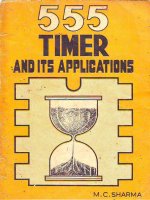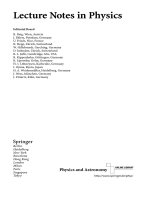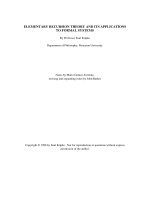harmonic_division and its application
Bạn đang xem bản rút gọn của tài liệu. Xem và tải ngay bản đầy đủ của tài liệu tại đây (145.39 KB, 10 trang )
Harmonic Division and its Applications
Cosmin Pohoata
Let d be a line and A, B, C and D four points which lie in this order on it.
The four-point (ABCD) is called a harmonic division, or simply harmonic, if (using
directed lengths)
CA
CB
= −
DA
DB
.
If X is a point not lying on d, then we say that pencil X(ABCD) (which consists
of the four lines XA, XB, XC, XD) is harmonic if (ABCD) is harmonic.
A
B
C
D
In this note, we show how to use harmonic division as a tool in solving some
difficult Euclidean geometry problems.
We begin by stating two very useful lemmas without proof. The first lemma
shows one of the simplest geometric characterizations of harmonic divisions, based
on the theorems of Menelaus and Ceva.
Lemma 1. In a triangle ABC consider three points X, Y , Z on the sides BC,
CA, respective AB. If X
is the point of intersection of Y Z with the extended side
BC, then the four-point (BXCX
) forms and harmonic division if and only if the
cevians AX, BY and CZ are concurrent.
X
P
Y
B
X
'
A
C
Z
The second lemma is a consequence of the Appollonius circle property. It can
be found in [1] followed by several interpretations.
Lemma 2. Let four points A, B, C and D, in this order, lying on d. Then, if two
of the following three propositions are true, then the third is also true:
Mathematical Reflections 4 (2007) 1
(1) The division (ABCD) is harmonic.
(2) XB is the internal angle bisector of ∠AXC.
(3) XB ⊥ XD.
D
B
A
C
X
We begin our journey with a problem from the IMO 1995 Shortlist.
Problem 1. Let ABC be a triangle, and let D , E, F be the points of tangency of
the incircle of triangle ABC with the sides BC, CA and AB respectively. Let X be
in the interior of ABC such that the incircle of XBC touches XB, XC and BC in
Z, Y and D respectively. Prove that EF ZY is cyclic.
T
Y
Z
E
F
A
X
B
C
D
Solution. Denote T = BC ∩ EF . Because of the concurency of the lines AD, BE,
CF in the Gergonne point of triangle ABC, we deduce that the division (T BDC)
is harmonic. Similarly, the lines XD, BY and CZ are concurrent in the Gergonne
point of triangle XBC, so T ∈ Y Z as a consequence of Lemma 1.
Now expressing the power of point T with respect to the incircle of triangle AB C
and the incircle of triangle XBC we have that TD
2
= T E ·T F and TD
2
= T Z ·T Y .
So TE · T F = T Z · T Y , therefore the quadrilateral EF ZY is cyclic.
For our next application, we present a problem given at the Chinese IMO Team
Selection Test in 2002.
Problem 2. Let ABCD be a convex quadrilateral. Let E = AB ∩ CD, F =
AD ∩ BC, P = AC ∩ BD, and let O the foot of the perpendicular from P to the
line EF . Prove that ∠BOC = ∠AOD.
Mathematical Reflections 4 (2007) 2
S
T
O
P
E
F
A
B
D
C
Solution. Denote S = AC ∩ EF and T = BD ∩ EF. As from Lemma 1, we
deduce that the division (ET F S) is harmonic. Furthermore, the division (APCS)
is also harmonic, due to the pencil B(ET F S). But now, the pencil E(AP CS)
is harmonic, so by intersecting it with the line B D, it follows that the four-point
(BP DT ) is harmonic. Therefore, the pencil O(AP CS) is harmonic and OP ⊥ OS,
thus by Lemma 2, ∠POA = ∠P OC. Similarly, the pencil O(BP DT ) is harmonic
and OP ⊥ OT , thus again by Lemma 2, ∠P OB = ∠POD. It follows that ∠AOD =
∠BOC.
We continue with an interesting problem proposed by Dinu Serbanescu at the
Romanian Junior Balkan MO 2007, Team Selection Test.
Problem 3. Let ABC be a right triangle with ∠A = 90
◦
and let D be a point on
side AC. Denote by E the reflection of A across the line BD and F the intersection
point of CE with the perpendicular to BC at D . Prove that AF , DE and BC are
concurrent.
TY
X
Z
F
E
B
C
A
D
Solution. Denote the points X = AE ∩ BD, Y = AE ∩ BC, Z = AE ∩ DF and
T = DF ∩ BC. From Lemma 1, applied to triangle AEC and for the cevians AF
Mathematical Reflections 4 (2007) 3
and ED, we observe that the lines AF, DE and BC are concurrent if and only if
the division (AY EZ) is harmonic.
Since the quadrilateral XY T D is cyclic, tan XY B = tan XDZ, which is equiv-
alent to XB/XY = XZ/XD. So XB · XD = XY · XZ.
Since triangles XAB and XDA are similar, we have that XA
2
= XB · XD, so
XA
2
= XY ·XZ. Using XA = XE, we obtain that
Y A
Y E
=
ZA
ZE
, and thus the division
(AY EZ) is harmonic.
The next problem was proposed by the author and given at the Romanian IMO
Team Selection Test in 2007.
Problem 4. Let ABC be a triangle, let E, F be the tangency points of the incircle
Γ(I) to the sides AC, respectively AB, and let M be the midpoint of the side BC.
Let N = AM ∩ EF , let γ(M) be the circle of diameter BC, and let lines BI and
CI meet γ again at X and Y , res pe ctively. Prove that
NX
NY
=
AC
AB
.
D
Z
T
X
Y
N
F
E
M
I
A
B
C
Mathematical Reflections 4 (2007) 4
Solution. We will assume AB ≥ AC, so the solution matches a possible drawing.
Let T = EF ∩ BC (for AB = AC, T = ∞), and D the tangency point of Γ to BC.
Claim 1. In the configuration described above, for X
= BI ∩ EF , one has BX
⊥
CX
.
Proof. The fact that BI effectively intersects EF follows from ∠DF E =
1
2
(∠ABC+
∠BAC) =
1
2
π −
1
2
∠ACB <
1
2
π, and BI ⊥ DF (similarly, CI effectively intersects
EF ).
The division (TBDC) is harmonic, and triangles BF X
and BDX
are congru-
ent, therefore ∠TX
B = ∠DX
B, which is e quivalent to BX
⊥ CX
(similarly, for
Y
= CI ∩ EF , one has CY
⊥ BY
).
Claim 2. In the configuration described above, one has N = DI ∩ EF .
Proof. It is enough to prove that NI ⊥ BC. Let d be the line through A, parallel
to BC. Since the pencil A(BMC∞) is harmonic, it follows the division (F NEZ) is
harmonic, where Z = d ∩ EF . Therefore N lies on the polar of Z relative to circle
Γ, and as N ∈ EF (the polar of A), it follows that AZ is the polar of N relative
to circle Γ, hence N I ⊥ d, so NI ⊥ BC. In conclusion, since D I ⊥ BC, one has
N ∈ DI.
It follows, according to Claim 1, that X = X
and Y = Y
, therefore X, Y ∈ EF .
Since the division (T BDC) is harmonic, it follows that D lies on the polar p of T
relative to circle γ. But T M ⊥ p, so BC ⊥ p, and since DI ⊥ BC, it follows that p
is, in fact, DI.
Now, according to Claim 2, it follows that D, I, N are collinear. Since DN is
the polar, it means the division (T Y NX) is harmonic, thus the pencil D(T Y NX)
is harmonic. But DT ⊥ DN , so DN is the angle bisector of ∠XDY , hence
NX
NY
=
DX
DY
=
sin ∠DY X
sin ∠DXY
.
As quadrilaterals BDIY and CDIX are cyclic (since pairs of opposing angles are
right angles), it follows that
1
2
∠ABC = ∠DBI = ∠DY I =
1
2
∠DY X (triangles
CDY and CEY are congruent), so ∠DY X = ∠ABC. Similarly, ∠DXY = ∠ACB.
Therefore
NX
NY
=
DX
DY
=
sin ∠DY X
sin ∠DXY
=
sin ∠ABC
sin ∠ACB
=
AC
AB
.
The following problem was posted on the MathLinks forum [2]:
Problem 5. Let ABC be a triangle and ρ(I) its incircle. D, E and F are the points
of tangency of ρ(I) with BC, CA and AB respectively. Denote M = ρ(I) ∩ AD, N
the intersection of the circumcircle of CDM with DF and G = CN ∩ AB. Prove
that CD = 3F G.
Mathematical Reflections 4 (2007) 5
T
G
X
N
M
F
E
D
A
B
C
Solution. Denote X = EF ∩ CG and T = EF ∩ BC. Now because the four-point
(T BDC) forms an harmonic division, so does the pencil F (T BDC) and now by
intersecting it with the line CG , we obtain that the division (XGNC) is harmonic.
According to the Menelaus theorem applied to BCG for the transversal DN F,
we find that CD = 3GF is equivalent to CN = 3N G.
Since (XGNC) is harmonic,
N C
N G
=
XC
XG
, so it suffices to show that N is the
midpoint of CX.
Observe that ∠MEX = ∠MDF = ∠MCX, therefore the quadrilateral M ECX
is cyclic, which implies that ∠MXC = ∠MEA = ∠ADE and ∠MCX = ∠ADF .
Also, ∠CMN = ∠FDB and ∠XMN = ∠XMC− ∠CMN = ∠CEF −∠F DB =
∠EDC.
Using the above angle relations and the equation
NX
NC
=
sin ∠MCX
sin ∠MXC
·
sin ∠XM N
sin ∠CMN
,
we obtain that NC = NX, so
sin ∠F DA
sin ∠EDA
=
sin ∠BDF
sin ∠CDE
.
On other hand, DA coincides with a symmedian of triangle DEF , so
sin ∠F DA
sin ∠EDA
=
F D
ED
=
sin ∠DEF
sin ∠DF E
=
sin ∠BDF
sin ∠CDE
.
Therefore, N is the midpoint of CX.
Mathematical Reflections 4 (2007) 6
Let ABCD be a cyclic quadrilateral and X a point on the circle. Then, the
ABCD is called harmonic if the p encil X(ABCD) is harmonic. For a list of prop-
erties regarding the harmonic quadrilateral, interested readers may can consult [1]
and [3].
The following problem was given at an IMO Team Preparation Contest, held in
Bacau, Romania, in 2006.
Problem 6. Let ABCD be a convex quadrilateral, for which denote O = AC ∩BD .
If BO is a symmedian of triangle ABC and DO is a symmedian of triangle AD C,
prove that AO is a symmedian of triangle ABD.
O
S
C
T
B
D
A
Solution. Denote T
1
= DD ∩ AC, T
2
= BB ∩ AC, T = BB ∩ DD, where DD,
respective BB represents the tangent in D to the circumcircle of ADC and the
tangent in B to the circumcircle of ABC.
Since BO is a symmedian of triangle ABC and DO is a symmedian of triangle
ADC, the divisions (AOCT
1
) and (AOCT
2
) are harmonic, so T
1
= T
2
= T .
Hence, BD is the polar of T
1
with respect to the circumcircle of ADC and also
the polar of T
2
with respect to the circumcircle of ABC. But because T
1
= T
2
, we
deduce that the circles AB C and ADC coincide, i.e. the quadrilateral ABCD is
cyclic, and since the division (AOCT ) is harmonic, the pencil D(AOCT ) is, and by
intersecting it by the circle ABCD, it follows that the quadrilateral ABCD is also
harmonic. Then, the pencil A(ABCD) is harmonic. By intersecting it with the line
BD, we see that the division (BODS) is harmonic, where S = AA ∩ BD. It follows
that AO is a symmedian of triangle BAD.
The next problem was also given in an IMO Team Preparation Test, at the
IMAR Contest, held in Bucharest in 2006.
Problem 7. Let ABC be an isosceles triangle with AB = AC, and M the midpoint
of BC. Find the locus of the point P interior to the triangle for which ∠BP M +
∠CP A = π.
Mathematical Reflections 4 (2007) 7
S
D
M
I
A
C
B
P
Solution. Denote the point D as the intersection of the line AP with the circumcircle
of BP C and S = DP ∩ BC.
Since ∠SP C = 180 − ∠CP A, it follows that ∠BP S = ∠CP M.
From the Steiner theorem applied in to triangle BP C for the isogonals P S and
P M,
SB
SC
=
P B
2
P C
2
.
On other hand, using Sine Law, we obtain
SB
SC
=
DB
DC
·
sin ∠SDB
sin ∠SDC
=
DB
DC
·
sin ∠P CB
sin ∠P BC
=
DB
DC
·
P B
P C
.
Thus by the above relations, it follows that
DB
DC
=
P B
P C
, i.e. the quadrilateral
P BDC is harmonic, therefore the point A
= BB ∩ CC lies on the line P D.
If A
= A, then lines AB and AC are always tangent to the circle BP C, and
so the locus of P is the circle BIC, where I is the incircle of ABC. Otherwise, if
A
= A, then A
= AM ∩ P S ∩ BB ∩ CC, due to the fact that A
∈ PD and and
A = P S ∩ AM, therefore by maintaining the condition that A
= A, we obtain that
P S = AM, therefore P lies on AM .
The next problem was selected in the Senior BMO 2007 Shortlist, proposed by
the author.
Problem 8. Let ρ(O) be a circle and A a point outside it. Denote by B, C the
points where the tangents from A with respect to ρ(O) meet the circle, D the point
on ρ(O ), for which O ∈ AD, X the foot of the perpendicular from B to CD, Y
the midpoint of the line segment BX and by Z the second intersection of DY with
ρ(O). Prove that ZA ⊥ ZC.
Mathematical Reflections 4 (2007) 8
T
Z
H
Y
X
D
C
B
O
A
Solution. Let us call H = CO ∩ ρ(O). Thus DC ⊥ DH, so DHBX.
Because Y is the midpoint of BX, we deduce that the division (BY X∞) is
harmonic, so also is the pe ncil D(BY XH) and by intersecting it with ρ(O), it
follows that the quadrilateral HBZC is harmonic. Then, the pencil C(HBZC)
is harmonic, so by intersecting it with the line HZ, it follows that the division
(A
ZT H) is harmonic, w here A
= HZ ∩ CC and T = HZ ∩ BC.
So, the line CH is the polar of A
with respect to ρ(O), but CH = BC is the
polar of A as well, so A = A
, hence the points H, Z, A are collinear, therefore
ZA ⊥ ZC.
The last problem is a generalization of a problem by Virgil Nicula [4]. The
solution covers all concepts and methods presented throughout this paper.
Z
N
'
T
2
S
1
S
2
T
1
P
N
M
D
A
B
C
O
Mathematical Reflections 4 (2007) 9
Problem 9. Let d be a line and A, C, B, D four p oints in this order on it such that
the division (ACBD) is harmonic. Denote by M the midpoint of the line segment
CD. Let ω be a c ircle passing through A and M. Let NP be the diameter of ω
perpendicular to AM. Let lines NC, ND, P C, P D meet ω again at S
1
, T
1
, S
2
, T
2
,
respectively. Prove that B = S
1
T
1
∩ S
2
T
2
.
Solution. Since the four-point (ACBD) is harmonic, so is the pencil N(ACBD)
and by intersecting it with ω, it follows that the quadrilateral AS
1
N
T
1
is harmonic,
hence the lines S
1
S
1
, T
1
T
1
and AN
are concurrent, where N
= NB ∩ ω.
Because the tangent in N to ω is parallel with the line AM and since M
is the midpoint of CD, the division (CM D∞) is harmonic, therefore the pencil
N(NDMC) also is, and by intersecting it with ω, it follows that the quadrilateral
NT
1
MS
1
is harmonic, hence the lines S
1
S
1
, T
1
T
1
and MN are concurrent.
From the above two observations, we deduce that the lines S
1
S
1
, T
1
T
1
, M N,
AN
are concurrent at a point Z.
On the other hand, since the pencils B(AS
1
N
T
1
) and B(NT
1
MS
1
) are har-
monic, by intersecting them with ω, it follows that the quadrilaterals NT
3
MS
3
and
AS
3
N
T
3
harmonic, where S
3
= BS
1
∩ ω and T
3
= BT
1
∩ ω.
Similarly, we deduce that the lines S
3
S
3
, T
3
T
3
, M N and AN
are concurrent in
the same point Z.
Therefore, S
3
T
3
is the polar of Z with respect to ω, but so is S
1
T
1
, thus S
1
T
1
=
S
3
T
3
, so S
1
= S
3
and T
1
= T
3
, therefore the points S
1
, B, T
1
are collinear.
Similarly, the points S
2
, B, T
2
are collinear, from which it follows that B =
S
1
T
1
∩ S
2
T
2
.
References
[1] Virgil Nicula, Cosmin Pohoata. Diviziunea armonica. GIL, 2007.
[2] />[3] />[4] />Cosmin Pohoata
Mathematical Reflections 4 (2007) 10









